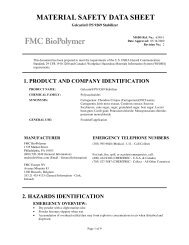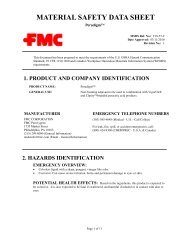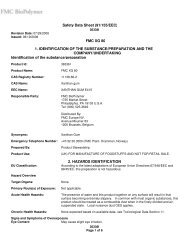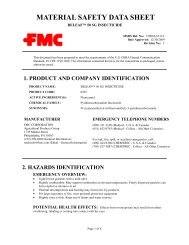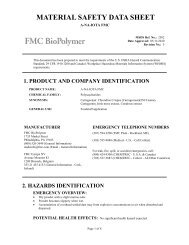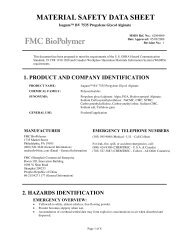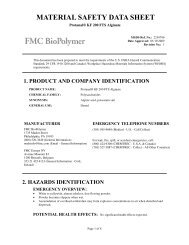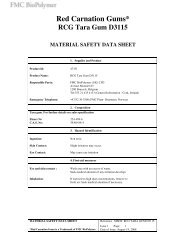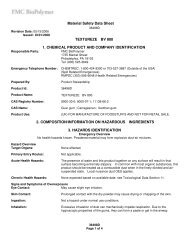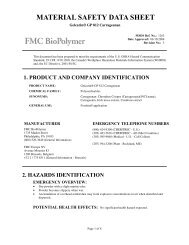material safety data sheet - FMC Corporation
material safety data sheet - FMC Corporation
material safety data sheet - FMC Corporation
You also want an ePaper? Increase the reach of your titles
YUMPU automatically turns print PDFs into web optimized ePapers that Google loves.
DUROX® HTP (7722-84-1-10) Date: 03/22/2007<br />
8. EXPOSURE CONTROLS / PERSONAL PROTECTION<br />
EXPOSURE LIMITS<br />
Chemical Name ACGIH OSHA Supplier<br />
Hydrogen Peroxide<br />
1 ppm (TWA)<br />
Page 4 of 11<br />
1 ppm (PEL)<br />
ENGINEERING CONTROLS: Ventilation should be provided to minimize the release of<br />
hydrogen peroxide vapors and mists into the work environment. Spills should be minimized or confined<br />
immediately to prevent release into the work area. Remove contaminated clothing immediately and wash<br />
before reuse.<br />
PERSONAL PROTECTIVE EQUIPMENT<br />
EYES AND FACE: Use chemical splash-type monogoggles and a full-face shield made<br />
of polycarbonate, acetate, polycarbonate/acetate, PETG or thermoplastic.<br />
RESPIRATORY: If concentrations in excess of 10 ppm are expected, use NIOSH/DHHS<br />
approved self-contained breathing apparatus (SCBA), or other approved atmospheric-supplied<br />
respirator (ASR) equipment (e.g., a full-face airline respirator (ALR)). DO NOT use any form of<br />
air-purifying respirator (APR) or filtering facepiece (AKA dust mask), especially those containing<br />
oxidizable sorbants such as activated carbon.<br />
PROTECTIVE CLOTHING: For body protection wear impervious clothing such as<br />
an approved splash protective suit made of SBR Rubber, PVC (PVC Outershell w/Polyester<br />
Substrate), Gore-Tex (Polyester trilaminate w/Gore-Tex), or a specialized HAZMAT Splash or<br />
Protective Suite (Level A, B, or C). For foot protection, wear approved boots made of NBR, PVC,<br />
Polyurethane, or neoprene. Overboots made of Latex or PVC, as well as firefighter boots or<br />
specialized HAZMAT boots are also permitted. DO NOT wear any form of boot or overboots<br />
made of nylon or nylon blends. DO NOT use cotton, wool or leather, as these <strong>material</strong>s react<br />
RAPIDLY with higher concentrations of hydrogen peroxide. Completely submerge hydrogen<br />
peroxide contaminated clothing or other <strong>material</strong>s in water prior to drying. Residual hydrogen<br />
peroxide, if allowed to dry on <strong>material</strong>s such as paper, fabrics, cotton, leather, wood or other<br />
combustibles can cause the <strong>material</strong> to ignite and result in a fire.<br />
GLOVES: For hand protection, wear approved gloves made of nitrile, PVC, or neoprene.<br />
DO NOT use cotton, wool or leather for these <strong>material</strong>s react RAPIDLY with higher<br />
concentrations of hydrogen peroxide. Thoroughly rinse the outside of gloves with water prior to<br />
removal. Inspect regularly for leaks.<br />
9. PHYSICAL AND CHEMICAL PROPERTIES<br />
ODOR: Odorless<br />
APPEARANCE: Clear, colorless liquid<br />
AUTOIGNITION TEMPERATURE: Non-combustible



